
Radios |
 |
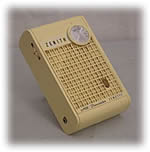 I am a radio enthusiast, DXer, listener and geek. It's my hobby, and thanks to the Internet, I know I'm not the only person on the planet who owned
well over a hundred radios, packed two or three for a weekend getaway
and drove people crazy during strong troposphere conditions. I've rated friend's homes by how good the reception was
in their yard. I've plugged in zip codes on radio-locator.com to map out
signal reception ranges for a trip. For many years I was tagged a bit odd for always carrying a radio, but now I can read about people who buy two
or three radios of the same model! (ok, guilty as charged).
I am a radio enthusiast, DXer, listener and geek. It's my hobby, and thanks to the Internet, I know I'm not the only person on the planet who owned
well over a hundred radios, packed two or three for a weekend getaway
and drove people crazy during strong troposphere conditions. I've rated friend's homes by how good the reception was
in their yard. I've plugged in zip codes on radio-locator.com to map out
signal reception ranges for a trip. For many years I was tagged a bit odd for always carrying a radio, but now I can read about people who buy two
or three radios of the same model! (ok, guilty as charged).
The following are two pages for the radio enthusiast; the first is an overview of my collection and the second is more a "straight-up" review of each model. At least I'm happy to say that after programming stations for a number of years and being on the air for the past 30, I've returned to my listening roots of listening to the radio for the sheer joy of listening to whatever comes in.
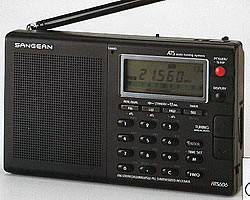 I hadn't purchased a radio worth more than $30 for a few years and that had been the GE Superadio II in 1983. Outside of a stereo system, I had never spent more that $100 on a portable radio, but I started reading about the Grundig
Yacht Boy 400PE, heralded as the radio of portable radios.
Sensitivity, selectivity and that renowned warm Grundig sound. It was just too tempting.
I hadn't purchased a radio worth more than $30 for a few years and that had been the GE Superadio II in 1983. Outside of a stereo system, I had never spent more that $100 on a portable radio, but I started reading about the Grundig
Yacht Boy 400PE, heralded as the radio of portable radios.
Sensitivity, selectivity and that renowned warm Grundig sound. It was just too tempting.
I bought one at Radio Shack and brought it home. I wasn't impressed. Performance wasn't on par with the $150 price tag. (Looking back, I think the price tag at that moment overruled any true impressions I may have had.) Plus, at around the size of a large paperback, it was bigger than I was used to carrying around (ok, I have lugged around the Superadio II and various boom boxes, but that was before the kids needed the back seat.) I returned it to Radio Shack and, unable to leave without something, grabbed the DX-399 at a close-out price of $60. I loved it! All the bells and whistles of the Grundig and great sound on AM and FM. I saw the Sangean equivalent, ATS-606, on eBay for $50 and purchased one as well! (See quote on www.radiointel.com about owning two of the same radios.) FM reception is as good as any portable radio I've encountered. AM is above average and SW is excellent. There's no SSB, but I have limited interest in Ham and CW broadcasts.
There's more on the review page - linked at the bottom.
So did I finally find radio nirvana? Was this the radio companion that would be the only one in my travel bag? I certainly thought so at the time, but fellow radio fanatics know the answer to that....
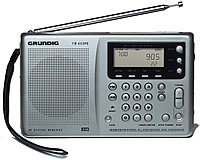 I decided that $60 on Ebay was worth plunking down on the Grundig
Yacht Boy 400PE. I'm glad I did. Unlike the original unit, this
radio is extremely sensitive on the AM and FM bands, excellent SW reception
and much warmer audio than I recall with the unit I returned. Living in an area (Long Island) best described as having the worst ground wave conductivity within the North American continent, the YB-400PE pulls in MW (AM) signals that I had only received previously on those glorious Delco AM car radios of yesteryear. Although bulky and requiring 6 AA batteries and more Grundigs in the fleet, it's still active
I decided that $60 on Ebay was worth plunking down on the Grundig
Yacht Boy 400PE. I'm glad I did. Unlike the original unit, this
radio is extremely sensitive on the AM and FM bands, excellent SW reception
and much warmer audio than I recall with the unit I returned. Living in an area (Long Island) best described as having the worst ground wave conductivity within the North American continent, the YB-400PE pulls in MW (AM) signals that I had only received previously on those glorious Delco AM car radios of yesteryear. Although bulky and requiring 6 AA batteries and more Grundigs in the fleet, it's still active
I've become a big fan of Grundig and their North American parent, Etón of Palo Alto, CA. I own both Sony and Sangean radios (and they offer great models), Grundig fits what I like best. For a while, it looked as if Etón was fading the Grundig nameplate into their own, but now they are two distinctive brands. Etón is the "emergency" crank radios, while Grundig stays with its short wave heritage. One of the reasons I have been such a fan is that while most radio companies have pulled back, Etón/Grundig is cranking out the new models with exciting features and styles. It was pointed out to me we have the Chinese to thank for that. China has become a very competitive market for radio, both broadcast and receivers. Companies like Tecsun and Kaito are building very impressive radios, many of which become new Grundig models. The latest breakthrough is a DSP chip (made here in the USA) that Tecsun is integrating into their receivers. This digital chip offers reception and selectivity never seen before. Currently, the Grundig G3 and G8 use this chip. More on my review of the G8 later.
Aside from a product line that has been mostly very impressive over the years, Etón's customer service exceeds above and beyond any company I have ever contacted.
A few years ago, my wife decided it would be easier to just buy me new radios as gifts. Although I swore I had enough, I haven't turned down any of the new models. At least she knows what I like.
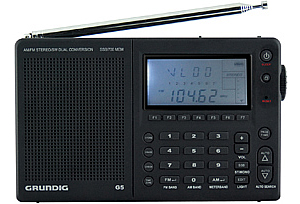 The first one she purchased was the Grundig G5. This was the replacement for the YB-400 and I had steered clear because of the push-button volume control. I need to have my finger on the control, acting as an independent AGC while I flip from one station to another. Yet as I spent more time with this unit, I quickly realized the vast improvement and features this radio offered. Yes, there are times when Vol 6 is too low and 7 is too high, but there's no more scratchy potentiometers to spray and this set-up allows you to set the volume of the radio when you wake up. The alarm system is phenomenal.
The first one she purchased was the Grundig G5. This was the replacement for the YB-400 and I had steered clear because of the push-button volume control. I need to have my finger on the control, acting as an independent AGC while I flip from one station to another. Yet as I spent more time with this unit, I quickly realized the vast improvement and features this radio offered. Yes, there are times when Vol 6 is too low and 7 is too high, but there's no more scratchy potentiometers to spray and this set-up allows you to set the volume of the radio when you wake up. The alarm system is phenomenal.
Also phenomenal is the radio's sensitivity and selectivity. On the FM band, it is simply the best. 104.1 comes in next to local 103.9. Not on 104.15 - right on frequency. The radio can be tuned with a dial, and that's helpful on the short wave band. AM is very sensitive, although it is susceptible to noise from the internal micro-processor on certain frequencies. Still, it has become one of my primary usage and favorite travel radios. Again, more following the link below.
I had the opportunity to play with the G5's upgrade - the G3. Comparison is here.
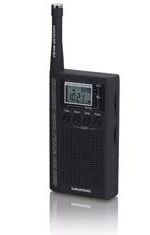 She also purchased the Mini 300, which blows the 100 (see below) away. Better sound, digital read-out (replete with analog drift!), alarm and the Etón/Grundig rubberized finish. The protruding antenna isn't as cumbersome as I thought it would be, although it will stick out of certain pockets. The best part is it looks more like a walkie-talkie than a radio, which is probably more acceptable - socially speaking!
She also purchased the Mini 300, which blows the 100 (see below) away. Better sound, digital read-out (replete with analog drift!), alarm and the Etón/Grundig rubberized finish. The protruding antenna isn't as cumbersome as I thought it would be, although it will stick out of certain pockets. The best part is it looks more like a walkie-talkie than a radio, which is probably more acceptable - socially speaking!
It's fairly sensitive on the FM band. Short Wave pulls in all the big guns. The analog dial makes it easy to locate signals, but it will take a little practice getting used to this very "quick" tuner. I would rate it average for MW.
My son decided to get in on the act and ask what type of radio I would like for Fathers Day. I told him "small" and that I had my eye on the Grundig 100. So he bought the massive Grundig S350DL.
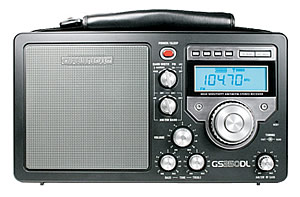 This is an analog radio with a digital dial and the "improved" version over the original 350. The improvements are "it's bigger," a larger speaker and it features a "tuning lock" to prevent drifting. This radio has a sound that would make Max Grundig proud. Not only is the FM on par with the GE Superadio II, but the AM is extremely sensitive and sounds fantastic. This is a great "camper" radio or something you want ready when the electricity goes out during a hurricane.
This is an analog radio with a digital dial and the "improved" version over the original 350. The improvements are "it's bigger," a larger speaker and it features a "tuning lock" to prevent drifting. This radio has a sound that would make Max Grundig proud. Not only is the FM on par with the GE Superadio II, but the AM is extremely sensitive and sounds fantastic. This is a great "camper" radio or something you want ready when the electricity goes out during a hurricane.
The radio plays forever on 4 D cell batteries, but if you can't find D's in the junk drawer, the unit has a place for 4 AA batteries that will keep you playing until you get to the battery store. Size has prevented me from packing this for travel, but I've spent many evenings in the hammock enjoying this radio's sound and sensitivity.
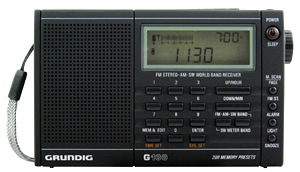 I eventually decided to take matters into my own hands and purchase the Grundig G100 from Universal radio. This radio shares the same interface with another favorite, the YB-550, so I was predicting a new "favorite" out of the box. Aside from massive overload on the MW band in urban areas and very stiff buttons, I found the sound of the speaker less than ideal for any size. This is the only radio that I have actually given to someone else, involving a trade for the Grundig G6.
I eventually decided to take matters into my own hands and purchase the Grundig G100 from Universal radio. This radio shares the same interface with another favorite, the YB-550, so I was predicting a new "favorite" out of the box. Aside from massive overload on the MW band in urban areas and very stiff buttons, I found the sound of the speaker less than ideal for any size. This is the only radio that I have actually given to someone else, involving a trade for the Grundig G6.
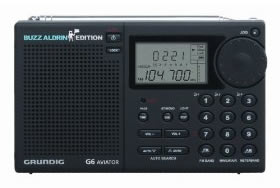 I originally had no interest in the G6. It looked like a mini-G5 with the VHF band added for Buzz Aldrin, who lent his name for the 40th anniversary of the moon landing and 50 years in space. Within a few days, I was blown away by this radio. It had ALL the features of the G5, sounded phenomenal for its size and felt very comfortable in my hands. Where the ergonomics of the YB-550 did not translate well to the G100, the lay-out of the G5 is improved by the leaner design.
I originally had no interest in the G6. It looked like a mini-G5 with the VHF band added for Buzz Aldrin, who lent his name for the 40th anniversary of the moon landing and 50 years in space. Within a few days, I was blown away by this radio. It had ALL the features of the G5, sounded phenomenal for its size and felt very comfortable in my hands. Where the ergonomics of the YB-550 did not translate well to the G100, the lay-out of the G5 is improved by the leaner design.
Again I must say that Etón has respected Max Grundig's penchant for superb-sounding radios and he would be impressed with this small wonder. I have never heard a radio this small sound as good. The amp to speaker ratio is just right, unfortunately, headphone volume suffers. For $100, this is one heck of a radio.
Can one radio take the place of all others? Well, no! But this one comes very close.
 Here
is a must-have for any radio collector; the Sony ICF-S10MK2.
For just 10 dollars on SonyStyle.com,
you get a pocket radio that brings back the quality of the early transistor
portable. Reception is great on AM and FM. Even the DX guys at Radiointel.com
love this one. AM reception is well above average, but the dial stops
at 1610 AM. FM is also above average, but will overload if there's a local
stick down the block. I've bought a total of eight so far, but aside from two -
gave them to friends! They're still available at Sony Style retail stores.
Here
is a must-have for any radio collector; the Sony ICF-S10MK2.
For just 10 dollars on SonyStyle.com,
you get a pocket radio that brings back the quality of the early transistor
portable. Reception is great on AM and FM. Even the DX guys at Radiointel.com
love this one. AM reception is well above average, but the dial stops
at 1610 AM. FM is also above average, but will overload if there's a local
stick down the block. I've bought a total of eight so far, but aside from two -
gave them to friends! They're still available at Sony Style retail stores.
I have to add this warning. A few of the recent ones I purchased seem to have a tinnier sound, compared to the original unit I purchased in 2003. And after a couple of years of service, this radio shows every bit of its $10 worth. The volume control has dead spots and it's just not holding up to constant use. But at this price, you can buy replacements!
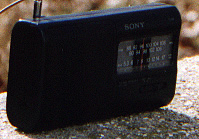 I
went a number of years just toting around a Sony ICF-310.
It was given to me from the prize closet of WMJC on the last day I was
there. (One of the many parting gifts from a great experience in my career.)
I wasn't much into "radio" as I was just wanting something to
listen to music when I traveled. And I was traveling a lot, so the tiny
size worked well. What I like most about this radio is its powerful sound.
Not quite as smooth as the S10MK2 above, but it will more than fill a
room with music. FM sensitivity is above average, although as most radios
this size; it is susceptible to overload from local stations. This unit is not as sensitive on AM. With a $14 price tag, it has held up far better than the S10MK2. Even though it's traveling days are over, the ICF-310 remains a sentimental
favorite that I still keep ready with fresh batteries for use around the house.
I
went a number of years just toting around a Sony ICF-310.
It was given to me from the prize closet of WMJC on the last day I was
there. (One of the many parting gifts from a great experience in my career.)
I wasn't much into "radio" as I was just wanting something to
listen to music when I traveled. And I was traveling a lot, so the tiny
size worked well. What I like most about this radio is its powerful sound.
Not quite as smooth as the S10MK2 above, but it will more than fill a
room with music. FM sensitivity is above average, although as most radios
this size; it is susceptible to overload from local stations. This unit is not as sensitive on AM. With a $14 price tag, it has held up far better than the S10MK2. Even though it's traveling days are over, the ICF-310 remains a sentimental
favorite that I still keep ready with fresh batteries for use around the house.
I've read that radio collectors are basically trying to find the radio of their childhood. While that's probably true to some extent, I've been looking for the radio I always yearned for when I was a kid. I grew up in an area where local AM service was limited and daytime only. Regional signals were spotty and even though I was some 70 miles from New York City, Long Island has poor ground wave conductivity. You definitely need a good receiver to get those clear channels "clearly." Nighttime listening was very inconsistent. When I discovered FM in 1967, I knew that was the future - for me at least. I bought my first Zenith AM/FM table top and was in heaven. However, most FM signals in the sixties and seventies on eastern Long Island came from Connecticut. My favorite station was WDRC-FM at 102.9 with a transmitter location about 45 miles away. Most FM pocket radios back then were not sensitive and the ones that were did not fit within my young budget. Many nights I'd spend camping out in the neighborhood listening not to the "Big D," but whatever I could get. 102.9 is still my first test reception with any new radio, and with local signals recently added at 102.5 and 103.3, selectivity is now equally as important as sensitivity.
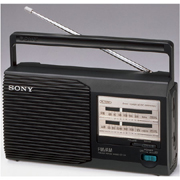 So
what portable radio would have fulfilled my adolescent desires back then? Well, I'm going to try and be
realistic. Would one of the new digital wunderkinds have been cool to show off? Absolutely, but I most certainly couldn't afford all the batteries needed to keep
these units going beyond 24 hours. Without a doubt, the perfect choice (and great
beach / yard) radio is the SONY ICF-24. Above average
sensitivity, slightly above-average selectivity on FM and superb AM reception plus solid audio from a decent speaker.
Four AA batteries with an in-cabinet AC plug and you're ready to go. This
unit is still available with different stylings and a larger speaker.
It can suffer from bad overload in a few instances, but yes, it pulls in WDRC-FM.
So
what portable radio would have fulfilled my adolescent desires back then? Well, I'm going to try and be
realistic. Would one of the new digital wunderkinds have been cool to show off? Absolutely, but I most certainly couldn't afford all the batteries needed to keep
these units going beyond 24 hours. Without a doubt, the perfect choice (and great
beach / yard) radio is the SONY ICF-24. Above average
sensitivity, slightly above-average selectivity on FM and superb AM reception plus solid audio from a decent speaker.
Four AA batteries with an in-cabinet AC plug and you're ready to go. This
unit is still available with different stylings and a larger speaker.
It can suffer from bad overload in a few instances, but yes, it pulls in WDRC-FM.
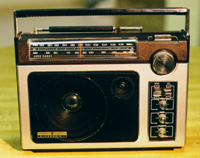 |
Now that's my opinion as an adult looking back. If I were 12 and had my pick, I know I'd go for the GE Superadio II. Back then, the bigger the better; especially when it came to that enormous speaker peering out from behind the grill, and I would have had no problem hauling that baby around the woods and back-yard camp sites. Actually, this radio had a place on the back seat in the car (covered by a jacket of course) for a few years after I bought it. A one of a kind radio that was a classic when it was new. The SR III just doesn't cut it. |
| The GE Superadio II, better than I and III. Click here for info |
!
The Sangean DT-200V
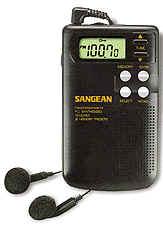 This
was another "must-have." All the reviews raved about its small size,
sound and reception. While it's not a bad little unit, it compares unfavorably to a similar
version I purchased from RadioShack.
This
was another "must-have." All the reviews raved about its small size,
sound and reception. While it's not a bad little unit, it compares unfavorably to a similar
version I purchased from RadioShack.
Although Radio Shack did carry Sangean radios under the RS or "Optimus" label, the 12-802 is not the same radio. Here is what the two units do have in common. They're both very small pocket / clip-on units that primarily use headphones for sound, but also feature a tiny speaker. Both are digital with FM stereo through the headphones.
Side by side, the DT-200V sounds slightly better in the headphones than the 12-802. I'm disappointed my unit is louder on the right channel, but I'll assume that's an anomaly.
The DT-200VX was a nice replacement. Lighted dial, better sensitivity and headphone sound were off-set by the fact that the memory system is aggravating. You are either in Memory mode or manual. Say you were at 90.7 and went to the memory mode. One of your memories is set to 104.1. Most radios would them be able to tune from that point, but this radio, when switched out of the memory tune mode, will bring you back to 90.7. For dial scanners, this is a pain.
Both radios have been discontinued due to the termination of analog TV.
Radio Shack 12-802
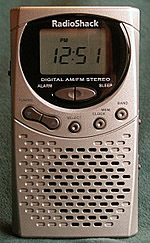 Bought this from Radio Shack while having a bad day back in 2004. This radio receives more inquiries from this page than any other and, no, it's not for sale! It's the perfect bedside radio with a nice sound from the speaker. No AC and loves consuming AAA batteries. (Sangean made it for RS) It uses a dangly wire (or headphones) for an antenna, but it is quite sensitive on both FM and AM, especially considering its small vertical design. However, selectivity
on the FM band is phenomenal. I can listen to 105.9 from forty-two miles
away without any interference from a class B on 106.1 twelve miles away.
Not even the Yacht Boy 400 handles this situation as well.
Bought this from Radio Shack while having a bad day back in 2004. This radio receives more inquiries from this page than any other and, no, it's not for sale! It's the perfect bedside radio with a nice sound from the speaker. No AC and loves consuming AAA batteries. (Sangean made it for RS) It uses a dangly wire (or headphones) for an antenna, but it is quite sensitive on both FM and AM, especially considering its small vertical design. However, selectivity
on the FM band is phenomenal. I can listen to 105.9 from forty-two miles
away without any interference from a class B on 106.1 twelve miles away.
Not even the Yacht Boy 400 handles this situation as well.
Comparisons with the Sangean above:
Speaker: Not only does the Radio Shack 12-802 have a slightly larger speaker in a smaller package than the Sangean, it has a switch called "e-bass" that gives the radio a fuller sound. Neither radio will fill a room, but bedside the 12-802 puts out better audio through the speaker than any small pocket radio.
The 12-802 comes with clock and alarm, the DT-200V does not. The DT-200V has TV audio, the 12-802 does not. I'd rather have an alarm than TV audio. (Note 2009: No brainer here, TV audio is kaput.) The DT-200V shuts off after 60 minutes whether you want it to or not, the 12-802 has an optional sleep timer that can be set as high as 90 minutes. The 12-802 will stand vertically, the DT-200V has a rounded bottom.
The only downside of the 12-802, and it's probably the biggest reason I tried the DT-200V, is that it takes AAA batteries rather than AA. Any experience with triple A's and digital gear means lots of batteries, but when used with the Lithium AAA's, it lasts a very reasonable amount of time. My problem is I tend to roam the dial a lot and all those digital maneuvers require energy. Out of all the radios on this page, I get the most emails asking about the 12-802. Despite a short run on the Radio Shack shelves, its reputation is reverberating with collectors.
I don't own one, but the Sangean DT-210 looks to be a close match to the 12-802. It's still available at Amazon.
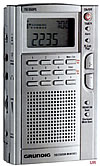
I purchased the YB-550PE. For a while, it looked as if the Grundig nameplate would fade into American parent Etón, but this was the last in the Yacht Boy series that Grundig featured over
the years. I continue a love-hate relationship with this radio; it
does some things very well and others not-so-good. FM and short wave are
superb, AM is average. Depending on where the radio is, it can either
sound great or somewhat fatiguing. And the interference from aircraft overriding weaker
FM signals is atrocious. But I love the vertical layout and the ergonomics are among my favorite.
Overall, it performs well in most places and makes a great "second" radio. (Fourth, fifth or sixth is equally acceptable.) I would say this is a good choice. Universal
Radio had been offering refurbished units. Keep an eye on their used list for sale.
Update: Four years after I purchased this radio, it's still one of my primary radios. As proof, one day I was attempting to lubricate the antenna with my fingertips, instead shocking the micro-processor into a coma which it would never recover. A refurbished unit on Universal Radio sells for $45. I paid $50 to have this one sent away and repaired. Many thanks to ACT Electronics of Nevada for bringing the 550 back to life.
Just before I packaged it up and sent it away, I had a conversation with one of the tech support at Universal. (Universal no longer repairs Grundig radios, but recommended ACT.) Why would I spend $50 instead of buying a new one for less? He told me of the story of a good fiend of his who played the bass for the local orchestra. Her original bass instrument had been damaged and she had to purchase a new one. Her playing suffered to the point where she was in jeopardy of losing her job with the orchestra. He told her to take an evening to "get to know her new instrument" by turning off all distractions, lighting some candles and just strumming the strings until she felt a connection. It worked. His point was that he felt most of us connect with certain inanimate things in our lives and that's why I wanted to spend the money on the radio I already owned.
By the way, if you're still reading after the above passage, you are a complete radio geek, or freak as my wife lovingly describes my hobby.
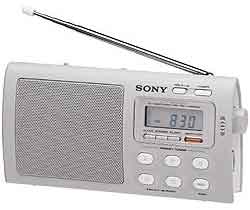 My friend showed up with a Sony ICF-M410V and after 10 minutes in my hands, I had to have one. So I bought two. Excellent reception on FM and AM and a speaker that rivals (occasionally bests) that of the YB-400PE with one caveat; the amp isn't as robust. At normal listening levels, this radio really shines, but take it outdoors or a noisy environment and you'll hit the threshold of distortion very quickly. FM is better than AM in this area.
My friend showed up with a Sony ICF-M410V and after 10 minutes in my hands, I had to have one. So I bought two. Excellent reception on FM and AM and a speaker that rivals (occasionally bests) that of the YB-400PE with one caveat; the amp isn't as robust. At normal listening levels, this radio really shines, but take it outdoors or a noisy environment and you'll hit the threshold of distortion very quickly. FM is better than AM in this area.
The unit features the defunct TV (VHF) and weather bands. If you're not a traditionalist in radio design, you'll enjoy this radio's "purse-styled" contours. No handle or strap, but light enough to carry around in one hand. Not a dial scanner's dream, there are only 5 presets per band with a funky twist knob to go up and down the dial. It's functional at best. Unlike myself however, most people aren't station hopping every three minutes.
Originally selling for around $40, recently this radio has spent time on eBay for $100 plus and used for $150-$175 on Amazon after it was discontinued. Certainly a testament to its reputation, but not worth that price. Still, I never considered selling one of mine!
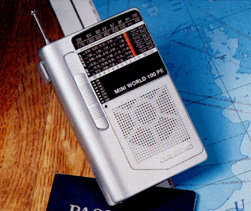 So what radio is numero uno? I've come to the conclusion that there is no perfect radio. Much like a photographer packing a camera and various lenses for a specific session, certain radios are better for individual instances. Need a hardy radio for the beach? The G5 or G6 gets packed among the blanket and towels. Want to catch the NY Mets play-by-play from 660 in NYC? YB-400PE brings it in clearly at a 3 on the signal meter. A quick bike ride? Slip the Grundig Mini 300 into your pocket. (Tanya refers to this little portable as my flask. My friend Jim insists it serves more as a pacemaker.) At this point, I've collected enough radios to insure that I'll always have the right one for every occasion. Maybe.
So what radio is numero uno? I've come to the conclusion that there is no perfect radio. Much like a photographer packing a camera and various lenses for a specific session, certain radios are better for individual instances. Need a hardy radio for the beach? The G5 or G6 gets packed among the blanket and towels. Want to catch the NY Mets play-by-play from 660 in NYC? YB-400PE brings it in clearly at a 3 on the signal meter. A quick bike ride? Slip the Grundig Mini 300 into your pocket. (Tanya refers to this little portable as my flask. My friend Jim insists it serves more as a pacemaker.) At this point, I've collected enough radios to insure that I'll always have the right one for every occasion. Maybe.
Note: Radio "The" Shack would not be my first choice for a radio purchase. I think the put "returns" back on the shelves. The Grundigs I've purchased there have a 75% chance of not working correctly. It's a good place to see the product, but I would recommend SonyStyle.com or Universal Radio. JR Electronics in New York City is also a good place for radios.
If the above info isn't enough and you want a few a more specific review of the above models, here you go. If you're interested in my thoughts regarding the G5 and G3 - go here.
Some radio pictures
courtesy of Joe Lynn. His radio collection
here
12-802 picture courtesy of Sarah Lowrey's amazing collection on transistor.org
Additional photo credits, tescun.com, sonystyle.com, sony.com.pa, and universal-radio.com
back
to the top
return to my radio career
back
to jack jr. home page.
back to kratoville.com